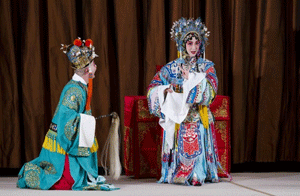“The Imperial Garden Banquet” from Palace of Everlasting Youth
Friday, August 16, 1 pm; Saturday, August 17, 1 and 2 pm
“Dreaming of the Phoenix”
Sunday, August 18, 2 pm
Experience classical and contemporary reflections on the Chinese legend of the phoenix. In the famous “Imperial Garden Banquet” scene from the 17th-century play Palace of Everlasting Youth (Friday and Saturday), a Tang-dynasty emperor and his consort portray traditional ideals of masculine (dragon) and feminine (phoenix) qualities as he confronts her fate amidst a political revolt. Chen Ming and Qian Yi play the leading roles, with accompaniment on Chinese flute (dizi), lute (pipa), fiddle (nan-hu), and percussion.
In the new music-theater work by Du Yun and Qian Yi (Sunday), “Dreaming of the Phoenix,” mountain spirits sing ancient poetry lamenting the loss of peace and prosperity since the departure of the phoenix. The vocalists are accompanied by Chinese flutes (dizi and xiao), lute (pipa), zither (gu-qin), and percussion. Presented in collaboration with the Wintergreen Kunqu Society.

